#kamal amrohi
Explore tagged Tumblr posts
Text


— Meena Kumari as Nargis/Sahibjaan in Pakeezah (1972)
#meena kumari#pakeezah#kamal amrohi#bollywood2#bollywoodedit#bollywoodgifs#bollywood gifs#70s bollywood#dailyworldcinema#dailywoc#dailybollywoodqueens#indian cinema#desi movies#southasiansource#filmgifs#filmedit#filmyshilmy#mine
148 notes
·
View notes
Text





Pakeezah (1972) | dir. Kamal Amrohi
#pakeezah#pakeezah 1972#kamal amrohi#meena kumari#veena#nadira#indian cinema#hindi cinema#bollywood#cinema#movies#films#world cinema#classic cinema#old bollywood#cinematography#1970s#aesthetics#aesthetic#historical movies#historical films#south asian cinema#asian cinema#indian movies#bollywood movies#hindi movies#indian films#bollywood films#hindi films#cinephile
208 notes
·
View notes
Text

Remembering Kamal Amrohi on his birth anniversary (17/01).
In these photos, He is with #MeenaKumari, Charlotte Wirsching, and Helen on the sets of ‘Dil Apna Aur Preet Parai’ during a break of song “Itni Badi Mehfil” (1959).
7 notes
·
View notes
Text
Meena Kumari in “Chalte chalte yunhi koi” (“Pakeezah”, 1972)
youtube
Meena Kumari (1933-1972), one of the greatest Indian actresses of the last century, in an iconic scene and song from the classic Indian movie Pakeezah (The Pure One-1972, written, directed, and produced by Kamal Amrohi).
Meena Kumari plays in this movie Sahibjaan, a tawaif. The tawaifs were courtesans who catered to the nobility of the Indian Subcontinent in the Mughal and post-Mughal eras and were trained in music, danse, theater, and Urdu literature. An orphan, Sahibjaan lives since her childhood in a kotha (brothel), but she wants to escape from her fate.
According to the website of the University of Iowa ( https://indiancinema.sites.uiowa.edu/pakeezah ):
““I’ve seen your feet; they’re very lovely. Don’t set them down on the earth—they’ll get soiled.” This metaphorical warning-note, penned by a romantic stranger and left between the toes of a sleeping woman in a railway compartment, forms a much-underscored motif in this classic courtesan film—the final collaboration between the great actress and dancer Meena Kumari and her former husband, actor and director Kamal Amrohi. Like MOTHER INDIA, this film coexists with its own legend involving the offscreen lives of the director and star, who planned it together in the late 1950s but whose marriage broke up around the time that filming began in 1964. Kumari (who was also a talented Urdu poet under the pen name Naaz) then purportedly became an alcoholic, but eventually came back to complete the film shortly before her premature death in 1972; aficionados may try their luck at identifying—from Kumari’s pained and sometimes mask-like face—which scenes were shot when. The central theme of the film is the struggle for respectability of a tawai’if, an Indo-Islamic courtesan trained in poetry, music, and dance—a glamorous “public woman” whose career was to be an elegant companion (and potential lover) to affluent men, but for whom a “respectable” marriage and home was out of the question. Her beautiful feet—apart from being an erotic fetish—represent her mastery of the art of North Indian classical dance or Kathak, which tawai’if’s preserved and nurtured for several centuries. The “earth” that such feet must perforce touch, however, is ruled by patriarchal society with its crippling double-standards, which decreed that respectable women (who lived in parda or seclusion) could seldom be interesting to men, and that interesting women were seldom respectable. All courtesan fiction struggles with this divide, which forms a principal theme of one of the earliest and most famous Urdu novels, Mirza Mohammed Hadi Ruswa’s UMRAO JAN ADA (1905; itself later filmed several times; see notes on UMRAO JAAN). PAKEEZAH offers another variation on the theme.”
See also about Pakeezah the paper of Richard Allen and Ira Brashkar Pakeezah: Dreamscape of Desire, on https://www.academia.edu/36264030/Pakeezah_Dreamscape_of_Desire
In the iconic scene of this video Sahibjaan/Meena Kumari sings and dances for the “villain” of the movie, an aristocrat (Nawab) named Zafar Ali Khan (played by Kamal Kapoor), who wishes to own her. The ambiguities and dynamics of the situation and of the relationship between the two are depicted in excellent way in this scene, which takes place at the Gulabi Mahal (Pink Palace) of Luchnow. According to the paper of Allen and Brashkar:
“The Gulabi Mahal (the Pink Palace) at Lucknow evokes a more rarified atmosphere. In Amrohi’s imagination, the space of the kotha is here fused with the idea of a Greek temple where the central colonnaded performance space doubles as a space of worship to the divine feminine, and discrete spaces are orchestrated in a theatrical hierarchy from the outer court with its fountains at the entrance to the inner sanctum sanctorum, which houses the bedroom of the courtesan, essentially off limits to all but the chosen client, and separated from the main performance space by a lighted causeway between reflecting pools of water.The Pink Palace is a sublime temple of femininity, whose fountains, atriums, reflecting pools form a microcosm of artifice that rivals that of the natural world. Indeed, even the moon appears artful in this landscape and the saturated deep blue sky, a studied backcloth to the whole.”
But, as the same article continues a bit further, the Pink Palace is also a prison for Sahibjaan:
“Meanwhile, for Sahibjaan whose desire for self-fulfillment has been awakened, the Pink Palace becomes a prison. In a metaphor that recurs in the film, and echoes throughout the genre, she is likened to a bird in a gilded cage from which she yearns to escape...
...The quality and texture of her performances for him [the Nawab] are now markedly different from her earlier ones. Gone is the vivacity and vibrancy of an Inhin logon ne or a Thade rahiyo as she mournfully sings the haunting Chalte Chalte, which articulates her desire for freedom and happiness.Yet it also returns us to the pathos of her entrapment in a manner that evokes the equation of the courtesan and the flickering flame that opens the film. At the conclusion of the performance, as she sings Yeh chiraag bujh rahein hain / Mere saath jalte jalte (These lamps are fading / As they burn with me), she hears the screech of a train whistle. It is impossible initially to discern whether it is somewhere physically off-screen or within her mind.The camera cranes upward from the floor to the red chandelier, recalling the red aalta of her feet.The lights darken as the escalating screech of the train whistle resounds through the performance space, taking over the song and abruptly bringing the dance to an end. When the camera cranes down again, the dancers have disappeared from the floor.The camera then tracks forward towards the fountains that abruptly stop playing as the whistling ends. It is as if the space in which she dwells, her erstwhile tomb, is now cut to the measure of her desire. She rushes to the balcony to see the train she has seen before, but this time it is motionless, silhouetted against the sky, almost as if waiting for her to come to her balcony before it can leave.Though real, the train appears as if in a vision, so detached is the spectacle from the space she inhabits.What is finally required for Sahibjaan to escape her sealed world is a transformation of environment and character of a magnitude that challenges the tone in which the film has hitherto been cast.”
The lyrics of Chalte chalte yuhni koi were written by the Urdu poet Kaifi Azmi (1919-2002) and its music was composed years before the release of Pakeezah by Ghulam Mohammed (1903-1968). Although Meena Kumari was also a singer, the voice in the song is of the great Indian singer Lata Mangeshkar (1929-2022).
Unfortunately I couldn’t do anything with the advertisements at the end of the video.
I have found on the net the following transliteration and translation of the lyrics of Chalte chalte yuhni koi:
Chalte chalte, chalte chalte While walking, while walking
Yun hi koi mil gaya tha I met someone by chance
Yun hi koi mil gaya tha I met someone by chance
Sare raah chalte chalte Walking around the path
Sare raah chalte chalte Walking around the path
Wahin thamke reh gayi hai Right there it stood still
Wahin thamke reh gayi hai Right there it stood still
Meri raat dhalte dhalte This night of mine, which is fading away
Meri raat dhalte dhalte This night of mine, which is fading away
Joh kahi gayi na mujhse What I was unable to say
Joh kahi gayi na mujhse What I was unable to say
Woh zamaana keh raha hai The world is saying that
Woh zamaana keh raha hai The world is saying that
Ke fasana A story
Ke fasana ban gayi hai A story has been created
Ke fasana ban gayi hai A story has been created
Meri baat chalte chalte From those words of mine
Meri baat chalte chalte From those words of mine
Yun hi koi mil gaya tha I met someone by chance
Yun hi koi mil gaya tha I met someone by chance
Sare raah chalte chalte Walking around the path
Sare raah chalte chalte Walking around the path
Yun hi koi mil gaya tha I met someone by chance
Sare raah Around the path
Chalte chalte, chalte chalte While walking, while walking
Sare raah Around the path
Chalte chalte, chalte chalte While walking, while walking
Chalte chalte, chalte chalte While walking, while walking
Yun hi koi mil gaya tha I met someone by chance
Yun hi koi mil gaya tha I met someone by chance
Shab-e-intezaar aakhir The night of waiting
Shab-e-intezaar aakhir The night of waiting
Kabhi hogi mukhtasar bhi Will after all shorten soon
Kabhi hogi mukhtasar bhi Will after all shorten soon
Yeh chirag These lamps
Yeh chirag bujh rahe hai These lamps are dying
Yeh chirag bujh rahe hai These lamps are dying
Mere saath jalte jalte As they burn alongside me
Mere saath jalte jalte As they burn alongside me
Yeh chirag bujh rahe hai These lamps are dying
Yeh chirag bujh rahe hai These lamps are dying
Yeh chirag bujh rahe hai These lamps are dying
Yeh chirag bujh rahe hai These lamps are dying
Yeh chirag bujh rahe hai These lamps are dying
Yeh chirag bujh rahe hai These lamps are dying
Mere saath jalte jalte As they burn alongside me
Mere saath jalte jalte As they burn alongside me
Yun hi koi mil gaya tha I met someone by chance
Yun hi koi mil gaya tha I met someone by chance
Sare raah chalte chalte Walking around the path
3 notes
·
View notes
Text

2 notes
·
View notes
Text
THE 236 GREATEST PERSONALITIES IN THE ENTIRE KNOWN HISTORY/COLLECTIVE CONSCIOUSNESS OF THIS WORLD! (@INDIES)
ie. THE 236 GREATEST PERSONALITIES IN WORLD HISTORY! (@INDIES)
Rajesh Khanna
Lionel Messi
Leonardo Da Vinci
Online Indie
Muhammad Ali
Joan of Arc
William Shakespeare
Vincent Van Gogh
J. K. Rowling
David Lean
Nadia Comaneci
Diego Maradona
Wolfgang Amadeus Mozart
Meena Kumari
Julius Caesar
Harrison Ford
Ludwig Van Beethoven
William W. Cargill
Fritz Hoffmann-La Roche
Samuel Curtis Johnson
Sam Walton
John D. Rockefeller
Andrew Carnegie
Roy Thomson
Tim Berners-Lee
Marie Curie
James J. Hill
Cornelius Vanderbilt
Roman Polanski
Samuel Slater
J. P. Morgan
Cary Grant
Dmitri Mendeleev
John Harvard
Alain Delon
Ramakrishna Paramhansa (Official God)
The Lumiere Brothers, Auguste & Louis
Carl Friedrich Benz
Michelangelo
Maharishi Mahesh Yogi
Ramana Maharishi
Mark Twain
Swami Sri Yukteswar Giri
Bruce Lee
Bhagwan Krishna (Official God)
Charlemagne
Rene Descartes
John F. Kennedy
Bhagwan Ganesha (Official God)
Walt Disney
Albert Einstein
Nikola Tesla
Alfred Hitchcock
Pythagoras
William Randolph Hearst
Cosimo de’ Medici
Johann Sebastian Bach
Alec Guinness
Nostradamus
Christopher Plummer
Archimedes
Jackie Chan
Guru Dutt
Amma Karunamayi/ Mata Parvati (Official God)
Peter Sellers
Gerard Depardieu
Joseph Safra
Robert Morris
Sean Connery
Petr Kellner
Aristotle Onassis
Usain Bolt
Jack Welch
Alfredo di Stefano
Elizabeth Taylor
Michael Jordan
Paul Muni
Steven Spielberg
Louis Pasteur
Ingrid Bergman
Norma Shearer
Dr. B. R. Ambedkar
Ayn Rand
Jesus Christ (Official God)
Luciano Pavarotti
Alain Resnais
Frank Sinatra
Allah (Official God)
Richard Nixon
Charlie Chaplin
Thomas Alva Edison
Alexander Graham Bell
Wright Brothers
Arjun (of Bhagwan Krishna’s Gita)
Jim Simons
George Lucas
Swami Sri Lahiri Mahasaya
Carl Lewis
Brett Favre
Helen Keller
Bernard Mannes Baruch
Buddha (Official God)
Hugh Grant
K. L. Saigal
Roger Federer
Rash Behari Bose
Tiger Woods
William Blake
Jesse Owens
Claude Miller
Bernardo Bertolucci
Subhash Chandra Bose
Satyajit Ray
Hippocrates
Chiang Kai-Shek
John Logie Baird
Geeta Dutt
Raphael (painter)
Bhagwan Shiva (Official God)
Radha (Ancient Krishna devotee)
George Orwell
Jorge Paulo Lemann
Catherine Deneuve
Pierre-Auguste Renoir
Bill Gates
Bhagwan Ram (Official God)
Michael Phelps
Michael Faraday
Audrey Hepburn
Dalai Lama
Grace Kelly
Mikhail Gorbachev
Vladimir Putin
Galileo Galilei
Gary Cooper
Roger Moore
John Huston
Blaise Pascal
Humphrey Bogart
Rudyard Kipling
Samuel Morse
Wayne Gretzky
Yogi Berra
Barry Levinson
Patrice Chereau (director)
Jerry Lewis
Louis Daguerre
James Watt
Henri Rousseau
Nikita Krushchev
Jack Dorsey
Dev Anand
Elia Kazan
Alexander Fleming
David Selznick
Frank Marshall
Viswanathan Anand
Major Dhyan Chand
Swami Vivekananda
Felix Rohatyn
Sam Spiegel
Anand Bakshi
Victor Hugo
Bhagwan Sri Sathya Sai Baba (Official God)
Steve Jobs
Srinivasa Ramanujam
Lord Hanuman
Stanley Kubrick
Giotto
Voltaire
Diego Velazquez
Ernest Hemingway
Francis Ford Coppola
Michael Douglas
Kirk Douglas
Mario Lemieux
Kishore Kumar
James Stewart
Douglas Fairbanks
Confucius
Babe Ruth
Raj Kapoor
Titian aka Tiziano Vecelli
El Greco
Francisco de Goya
Jim Carrey
Mohammad Rafi
Steffi Graf
Pele
Gustave Courbet
Rani Laxmibai of Jhansi
Milos Forman
Steve Wozniak
Georgia O’ Keeffe
Mala Sinha
Aryabhatta
Magic Johnson
Patanjali
Leo Tolstoy
Tansen
Henry Fonda
Albrecht Durer
Benazir Bhutto
Cal Ripken Jr
Samuel Goldwyn
Mumtaz (actress)
Panini
Nicolaus Copernicus
Pablo Picasso
George Clooney
Olivia de Havilland
Prem Chand
Imran Khan
Pete Sampras
Ratan Tata
Meerabai (16th c. Krishna devotee)
Queen Elizabeth II
Pope John Paul II
James Cameron
Jack Ma
Warren Buffett
Romy Schneider
C. V. Raman
Aung San Suu Kyi
Benjamin Netanyahu
Frank Capra
Michael Schumacher
Steve Forbes
Paramhansa Yogananda
Tom Hanks
Kamal Amrohi
Hans Holbein
Shammi Kapoor
Gerardus Mercator
Edith Piaf
Bhagwan Shirdi Sai Baba (Official God) .

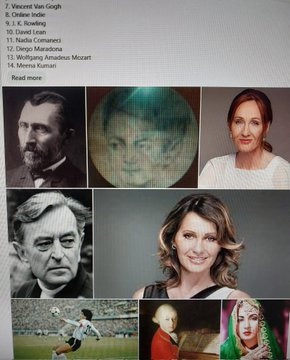
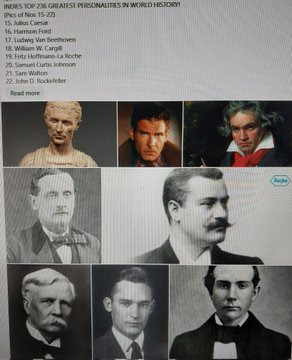
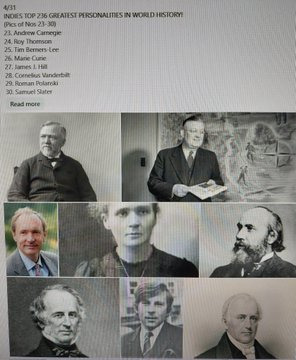
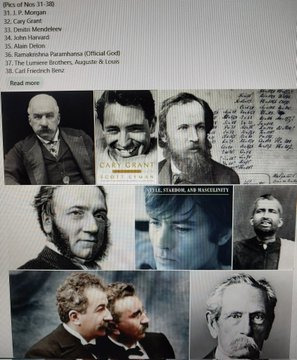

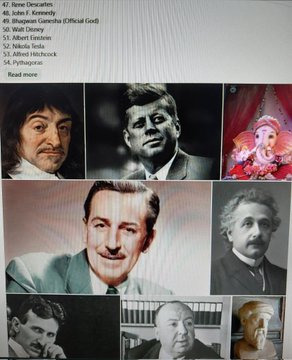


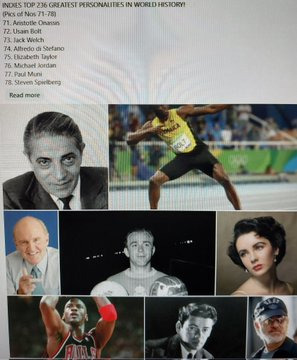
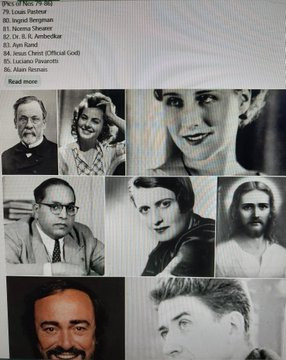
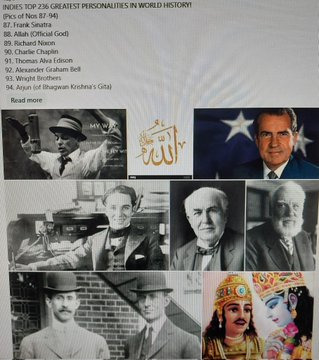
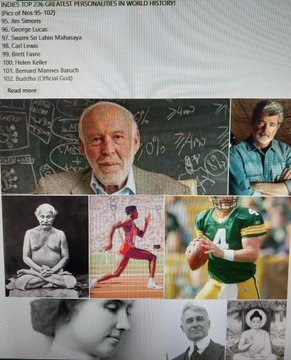

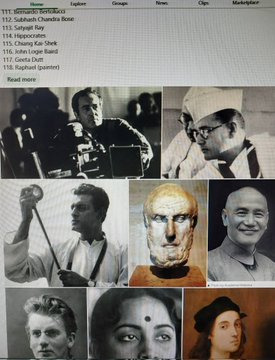

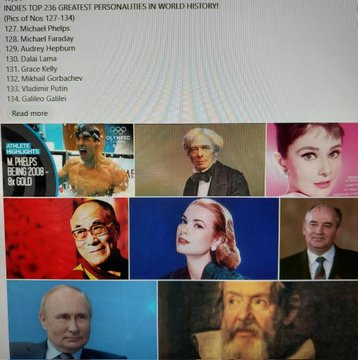
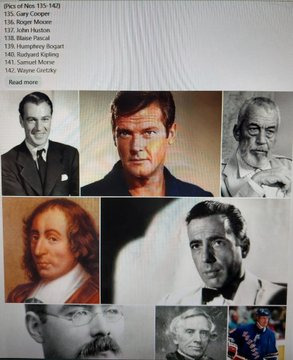
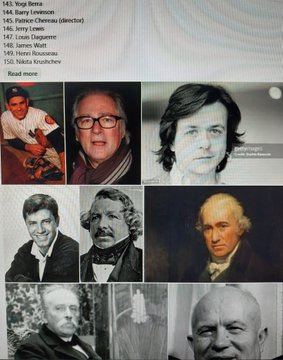
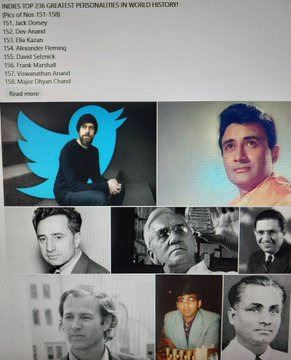
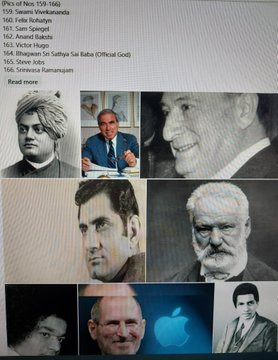
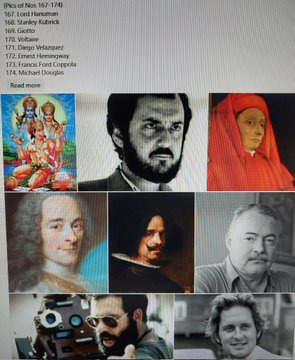

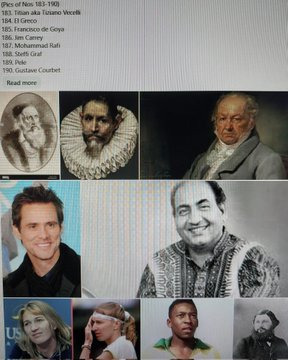
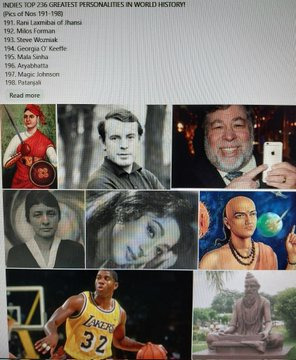
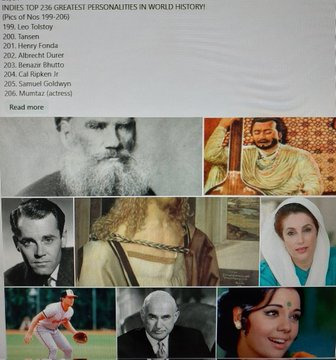
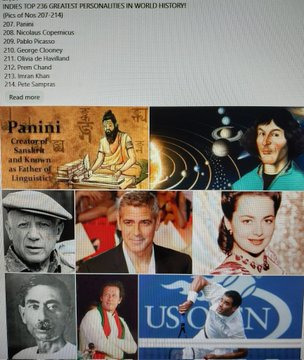
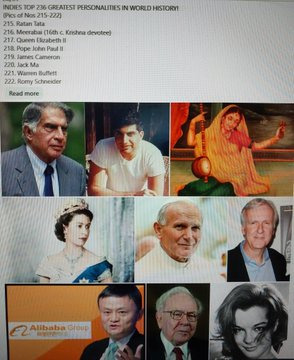
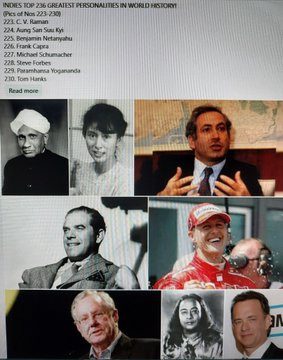
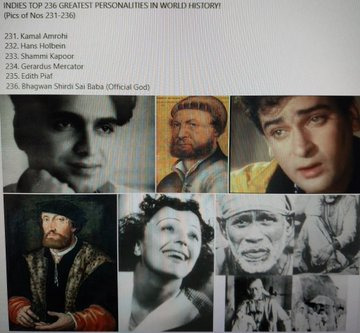
2 notes
·
View notes
Text
THE 236 GREATEST PERSONALITIES IN THE ENTIRE KNOWN HISTORY/COLLECTIVE CONSCIOUSNESS OF THIS WORLD! (@INDIES)
i.e. THE 236 GREATEST PERSONALITIES IN WORLD HISTORY! (@INDIES)
Rajesh Khanna
Lionel Messi
Leonardo Da Vinci
Muhammad Ali
Joan of Arc
William Shakespeare
Vincent Van Gogh
Online Indie
J. K. Rowling
David Lean
Nadia Comaneci
Diego Maradona
Wolfgang Amadeus Mozart
Meena Kumari
Julius Caesar
Harrison Ford
Ludwig Van Beethoven
William W. Cargill
Fritz Hoffmann-La Roche
Samuel Curtis Johnson
Sam Walton
John D. Rockefeller
Andrew Carnegie
Roy Thomson
Tim Berners-Lee
Marie Curie
James J. Hill
Cornelius Vanderbilt
Roman Polanski
Samuel Slater
J. P. Morgan
Cary Grant
Dmitri Mendeleev
John Harvard
Alain Delon
Ramakrishna Paramhansa (Official God)
The Lumiere Brothers, Auguste & Louis
Carl Friedrich Benz
Michelangelo
Maharishi Mahesh Yogi
Ramana Maharishi
Mark Twain
Swami Sri Yukteswar Giri
Bruce Lee
Bhagwan Krishna (Official God)
Charlemagne
Rene Descartes
John F. Kennedy
Bhagwan Ganesha (Official God)
Walt Disney
Albert Einstein
Nikola Tesla
Alfred Hitchcock
Pythagoras
William Randolph Hearst
Cosimo de’ Medici
Johann Sebastian Bach
Alec Guinness
Nostradamus
Christopher Plummer
Archimedes
Jackie Chan
Guru Dutt
Amma Karunamayi/ Mata Parvati (Official God)
Peter Sellers
Gerard Depardieu
Joseph Safra
Robert Morris
Sean Connery
Petr Kellner
Aristotle Onassis
Usain Bolt
Jack Welch
Alfredo di Stefano
Elizabeth Taylor
Michael Jordan
Paul Muni
Steven Spielberg
Louis Pasteur
Ingrid Bergman
Norma Shearer
Dr. B. R. Ambedkar
Ayn Rand
Jesus Christ (Official God)
Luciano Pavarotti
Alain Resnais
Frank Sinatra
Allah (Official God)
Richard Nixon
Charlie Chaplin
Thomas Alva Edison
Alexander Graham Bell
Wright Brothers
Arjun (of Bhagwan Krishna’s Gita)
Jim Simons
George Lucas
Swami Sri Lahiri Mahasaya
Carl Lewis
Brett Favre
Helen Keller
Bernard Mannes Baruch
Buddha (Official God)
Hugh Grant
K. L. Saigal
Roger Federer
Rash Behari Bose
Tiger Woods
William Blake
Jesse Owens
Claude Miller
Bernardo Bertolucci
Subhash Chandra Bose
Satyajit Ray
Hippocrates
Chiang Kai-Shek
John Logie Baird
Geeta Dutt
Raphael (painter)
Bhagwan Shiva (Official God)
Radha (Ancient Krishna devotee)
George Orwell
Jorge Paulo Lemann
Catherine Deneuve
Pierre-Auguste Renoir
Bill Gates
Bhagwan Ram (Official God)
Michael Phelps
Michael Faraday
Audrey Hepburn
Dalai Lama
Grace Kelly
Mikhail Gorbachev
Vladimir Putin
Galileo Galilei
Gary Cooper
Roger Moore
John Huston
Blaise Pascal
Humphrey Bogart
Rudyard Kipling
Samuel Morse
Wayne Gretzky
Yogi Berra
Barry Levinson
Patrice Chereau (director)
Jerry Lewis
Louis Daguerre
James Watt
Henri Rousseau
Nikita Krushchev
Jack Dorsey
Dev Anand
Elia Kazan
Alexander Fleming
David Selznick
Frank Marshall
Viswanathan Anand
Major Dhyan Chand
Swami Vivekananda
Felix Rohatyn
Sam Spiegel
Anand Bakshi
Victor Hugo
Bhagwan Sri Sathya Sai Baba (Official God)
Steve Jobs
Srinivasa Ramanujam
Lord Hanuman
Stanley Kubrick
Giotto
Voltaire
Diego Velazquez
Ernest Hemingway
Francis Ford Coppola
Michael Douglas
Kirk Douglas
Mario Lemieux
Kishore Kumar
James Stewart
Douglas Fairbanks
Confucius
Babe Ruth
Raj Kapoor
Titian aka Tiziano Vecelli
El Greco
Francisco de Goya
Jim Carrey
Mohammad Rafi
Steffi Graf
Pele
Gustave Courbet
Rani Laxmibai of Jhansi
Milos Forman
Steve Wozniak
Georgia O’ Keeffe
Mala Sinha
Aryabhatta
Magic Johnson
Patanjali
Leo Tolstoy
Tansen
Henry Fonda
Albrecht Durer
Benazir Bhutto
Cal Ripken Jr
Samuel Goldwyn
Mumtaz (actress)
Panini
Nicolaus Copernicus
Pablo Picasso
George Clooney
Olivia de Havilland
Prem Chand
Imran Khan
Pete Sampras
Ratan Tata
Meerabai (16th c. Krishna devotee)
Queen Elizabeth II
Pope John Paul II
James Cameron
Jack Ma
Warren Buffett
Romy Schneider
C. V. Raman
Aung San Suu Kyi
Benjamin Netanyahu
Frank Capra
Michael Schumacher
Steve Forbes
Paramhansa Yogananda
Tom Hanks
Kamal Amrohi
Hans Holbein
Shammi Kapoor
Gerardus Mercator
Edith Piaf
Bhagwan Shirdi Sai Baba (Official God)
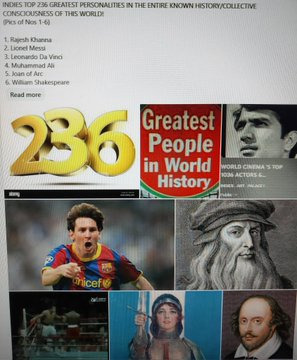




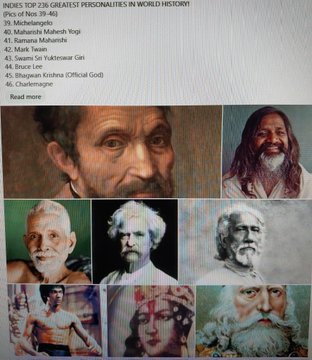
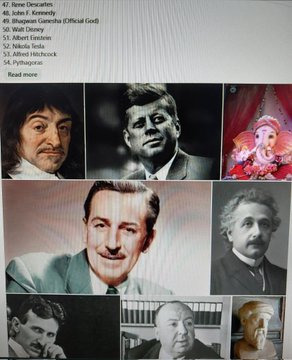
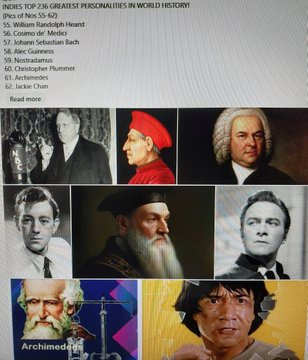
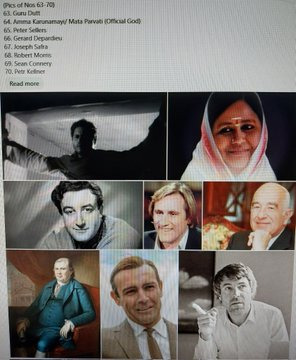


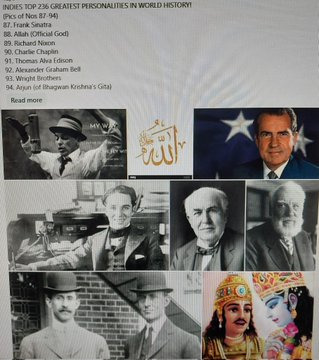
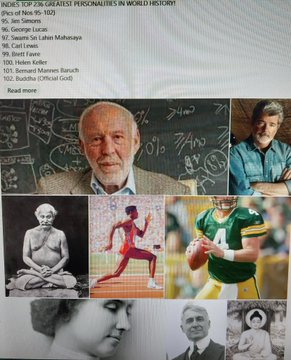
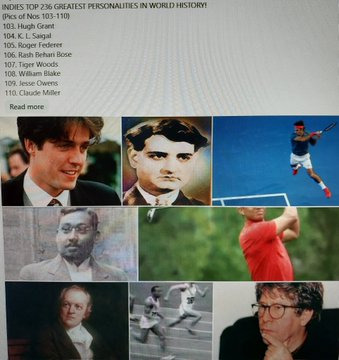
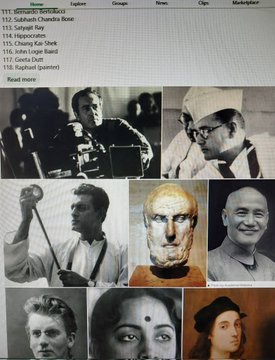

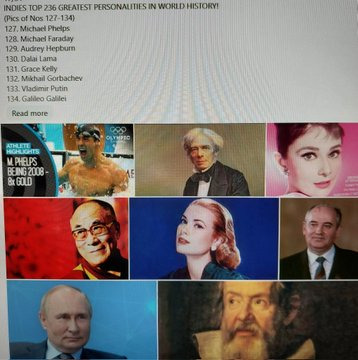
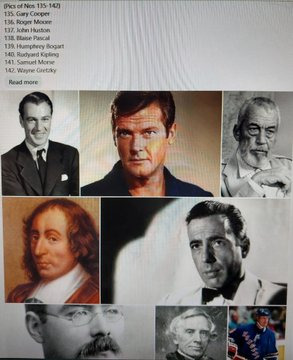
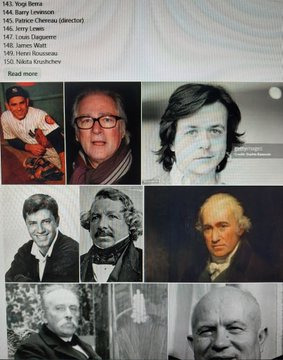

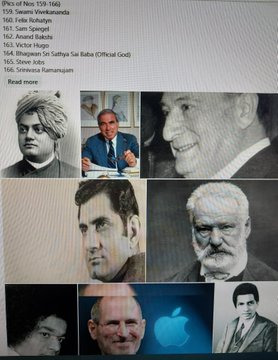
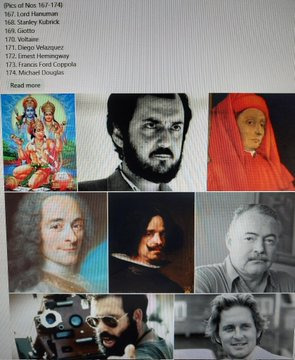
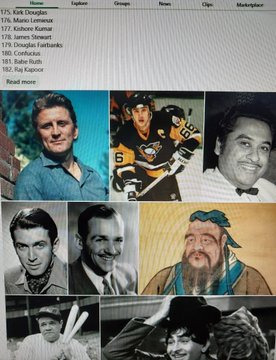
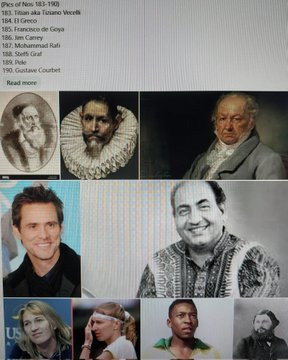
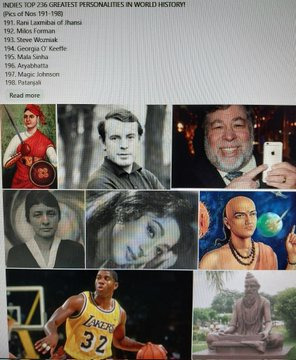
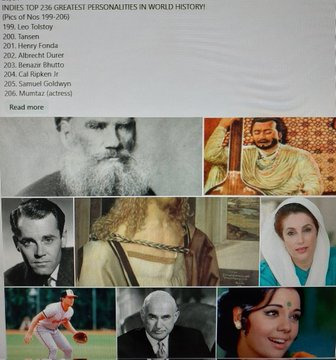

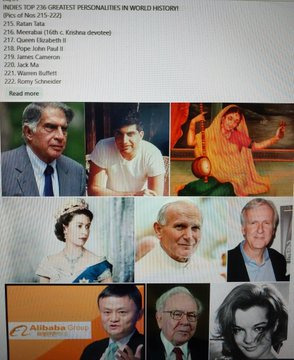

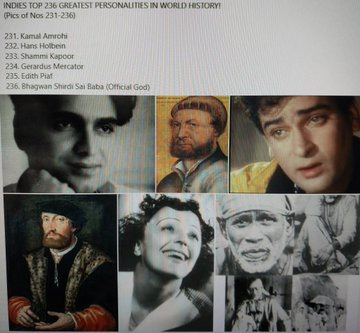
4 notes
·
View notes
Text

Film Studios Are Being Sold – The Industry Is in Danger!
R.K. Studios, Cinevistaas, Kamal Amrohi… and now many more studios are on the verge of being sold!
❗ If studios do not survive, where will artists and cinema workers go?
✅ Studios are not just brick and mortar; they are the foundation of the film industry!
✅ “When cinema workers thrive, only then will the industry grow!”
✅ “If studios disappear today, the film industry will not exist tomorrow!”
✅ “Respect those who create cinema!”
AICWA – The Last Hope for Cinema Workers!
📞 Call us for support: 7700999457
🌐 Visit our website: www.aicwa.in
| @aicwaofficial | @bollywood | @hollywood |
| #SaveFilmStudios |
#SupportCinemaWorkers |
#AICWA | #AllIndianCineWorkersAssociation |
#IndianFilmIndustry | #FilmIndustry |
#CineWorkersRights |
#RespectCinemaCreators |
#Bollywood |
#FilmIndustryCrisis |
0 notes
Text

Film Studios Are Being Sold – The Industry Is in Danger!
R.K. Studios, Cinevistaas, Kamal Amrohi… and now many more studios are on the verge of being sold!
❗ If studios do not survive, where will artists and cinema workers go?
✅ Studios are not just brick and mortar; they are the foundation of the film industry!
✅ “When cinema workers thrive, only then will the industry grow!”
✅ “If studios disappear today, the film industry will not exist tomorrow!”
✅ “Respect those who create cinema!”
AICWA – The Last Hope for Cinema Workers!
📞 Call us for support: 7700999457
🌐 Visit our website: www.aicwa.in
| #SaveFilmStudios |
#SupportCinemaWorkers |
#AICWA | #AllIndianCineWorkersAssociation |
#IndianFilmIndustry | #FilmIndustry |
#CineWorkersRights |
#RespectCinemaCreators |
#Bollywood |
#FilmIndustryCrisis |
0 notes
Text

Kamal Amrohi birth anniversary : Wishes From Bandya Mama
कमाल अमरोही के जन्मदिन से शाहरुख खान की 'सारे जहां से अच्छा' तक, ये हैं मनोरंजन जगत की बड़ी खबरें
0 notes
Text




Pakeezah (1972) | dir. Kamal Amrohi
#pakeezah#pakeezah 1972#kamal amrohi#indian cinema#hindi cinema#bollywood#cinema#movies#films#world cinema#classic cinema#old bollywood#1970s#cinematography#south asian cinema#asian cinema#indian movies#hindi movies#bollywood movies#bollywood films#indian films#hindi films#classic bollywood#aesthetics#aesthetic#cinephile
191 notes
·
View notes
Text

Remembering #KamalAmrohi on his 31st death anniversary (11/02/93).
As a director, he developed a style that combined a stylised direction with minimalist performances. This style was different from the one with expressive acting that was common in the Indian cinema of his period.
Kamal Amrohi was born in Amroha, which was part of British India and is now in Uttar Pradesh, India. He changed his name to Kamal Amrohi later. He was related to two Pakistani writers, Jaun Elia and Rais Amrohvi, as their first cousin. In 1938, Kamal left his hometown to study in Lahore, which is now in Pakistan. There, a singer named K. L. Saigal found him and brought him to Mumbai to work in films. He started his film career at Sohrab Modi's film company, Minerva Movietone, and worked on movies like "Jailor," "Pukar," and "Bharosa."
Kamal Amrohi became a film director in 1949 with his first movie "Mahal," which had famous actors Madhubala and Ashok Kumar. This movie was known for its music. He directed only four movies in total, including "Daaera" with Meena Kumari and Nasir Khan, and "Pakeezah," which took a long time to make and was released in 1972. "Pakeezah" is considered a special movie in India, even though it had some flaws. Meena Kumari, who was a famous actress and Kamal's wife, praised "Pakeezah" as Kamal's tribute to her. His last movie was "Razia Sultan" in 1983. He also started making a film called "Majnoon" but it was never finished.
Kamal Amrohi also wrote scripts for other directors and was one of the writers for the famous movie "Mughal-e-Azam" in 1960, which won him an award. His style of directing was known for being different and unique, focusing more on the visual style and less on dramatic acting.
In 1958, he opened a studio named Kamaal Studios, but it closed after three years. He had planned to make another movie called "Aakhri Mughal" but it was never made. Film maker J P Dutta wanted to make this movie in the late 1990s and again in 2007, but it didn't happen. Kamal Amrohi died on February 11, 1993, in Mumbai, 21 years after his wife, Meena Kumari, passed away. He was buried next to her in Mumbai.
Six days after he died, a newspaper in the UK called The Independent wrote about him, saying he was a big figure in the Hindi film industry for over 50 years.
2 notes
·
View notes
Text
Sandeep Marwah Special Guest at Exhibition of Cinematic Heritage

New Delhi: The Visual Art Gallery at India Habitat Centre, Lodi Road, became a hub of cultural nostalgia as it hosted an extraordinary exhibition showcasing rare photographs and posters from the glorious history of Indian cinema. The event was graced by the esteemed presence of Dr. Sandeep Marwah, President of Marwah Studios and Chancellor of AAFT University, who expressed his admiration for the rich cinematic legacy on display.
“This exhibition is a remarkable tribute to the strength and diversity of Indian cinema. Standing here, you can journey back over a century and witness the evolution of our film industry through these timeless visuals,” said Dr. Marwah. He commended the exhibition for its meticulous curation of iconic moments from Indian cinema, offering a rare glimpse into the past that continues to shape the present.
The exhibition, designed and prepared by the Neville Tuli Research Centre for India Studies, featured an impressive array of posters and photographs that capture the essence of Indian cinema’s golden era. The event also included an insightful conversation led by Rinki Roy, daughter of legendary filmmaker Bimal Roy, and Tajdar Amrohi, son of cinematic icon Kamal Amrohi. They shared personal anecdotes and discussed the indelible impact of their parents on Indian cinema, offering attendees a unique perspective on the lives and works of these celebrated figures. This segment, initiated by Neville Tuli, further enriched the cultural significance of the event.
In his remarks to the press, Dr. Marwah emphasized the importance of such exhibitions in fostering a vibrant film culture in the city. “These kinds of exhibitions and conversations are crucial for keeping the spirit of cinema alive. Delhi has always been a city that embraces art, and this event has undoubtedly injected a new wave of excitement into its cultural landscape. It is essential that we remember and celebrate the works of these giant filmmakers, such as Kamal Amrohi and Bimal Roy, who have left an indelible mark on the history of Indian cinema.”
The exhibition serves as a poignant reminder of the rich heritage of Indian cinema and the visionary artists who have shaped it. As attendees explored the gallery, they were not only witnesses to the past but also participants in a dialogue that continues to influence the future of filmmaking.
#Sandeep Marwah Special Guest at Exhibition of Cinematic Heritage#Dr. Sandeep Marwah President of AAFT
0 notes
Text
Film Review: महल/Mahal/Palace (Kamal Amrohi, 1949)
महल/Mahal/Palace [the other title shown is in Urdu] (Kamal Amrohi, 1949) is an excellent film. It needs a restoration. Maybe The Criterion Collection or Kino Lorber could get interested. It’s kind of a horror film, but the horrific elements (apart from a scene where Rajni is terrified by a python and some bats, the latter of which kill the former) are revealed to be a hoax playing into belief in…

View On WordPress
0 notes
Text
THE 100 GREATEST DIRECTORS IN THE HISTORY OF WORLD CINEMA! (@INDIES)
.Roman Polanski
.David Lean
.Alfred Hitchcock
.Frank Capra
.Elia Kazan
.Dasari Narayana Rao
.Fred Zinnemann
.Milos Forman
.Kamal Amrohi
.Peter Jackson
.John Huston
.Billy Wilder
.Frank Lloyd
.Roland Joffe
.Lekh Tandon
.Asit Sen
.B.R. Chopra
.Edgar Wright
.Chris Columbus
.Ernst Lubitsch
.Alain Resnais
.Guru Dutt
.George Cukor
.Ivan Reitman
.Mahesh Kaul
.Jayant Desai
.Richard Curtis
.Robert Clouse
.Basu Bhattacharya
.Maurice Pialat
.David MacDonald
.Mel Gibson
.Anthony Minghella
.Jamie Uys
.Joseph Mankiewicz
.Pierre Chenal
.David Fincher
.Ken McMullen
.Jeremy Leven
.Mary McGuckian
.Alfonso Cuaron
.Rob Reiner
.Delbert Mann
.Louis Malle
.John Cromwell
.Charles Chaplin
.A. Bhimsingh
.Jean Delannoy
.Mervyn LeRoy
.Nancy Meyers
.William Wyler
.Bhargava (Kannada)
.Jonathan Lynn
.Peter Weir
.Robert Rossen
.Roger Michell
.Robert Zemeckis
.Robert Z. Leonard
.J. Lee Thompson
.Robert Wise
.Jerome Hill
.Anthony Quinn
.Jacques Audiard
.Agnes Jaoui
.Mervyn LeRoy
.Roland Emmerich
.Wallace Worsley
.Stephen Herek
.Blake Edwards
.Andrew Fleming
.John Frankenheimer
.Claude Autant-Lara
.Kenneth Branagh
.Lasse Halstrom
.Ralph Nelson
.Andrei Tarkovsky
.Robert Stevenson
.John Madden
.Stanley Kramer
.Olivier Dahan
.Norman Z. McLeod
.Mike Newell
.Raymond Rouleau
.Michael Curtiz
.Nora Ephron
.Arthur Hiller
.Vittorio De Sica
.Bernardo Bertolucci
.Sohrab Modi
.John McTiernan
.Steven Spielberg
.Tay Garnett
.Abel Gance
.Richard Linklater
.Merian C. Cooper
.Michael Bay
.Renny Harlin
.Victor Fleming
.Phil Karlson
.Satyajit Ray
.David Yates
.John Guillermin
.Oliver Stone
.James Cameron
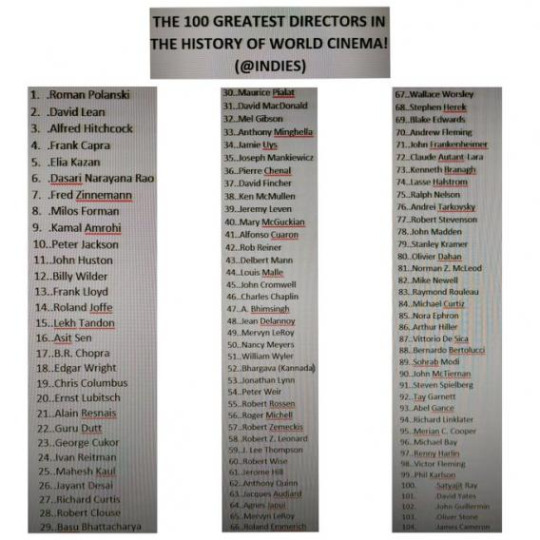

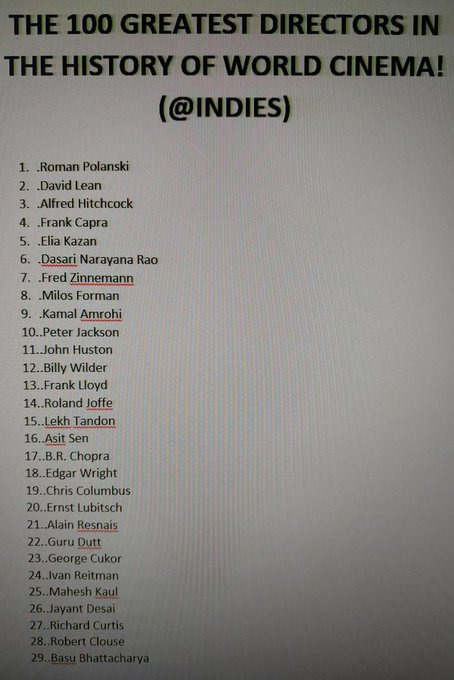


1 note
·
View note
Video
youtube
"PAKEEZAH" - MOVIE REVIEW | KAMAL AMROHI MOVIE | CINEMA TALKIES |
0 notes